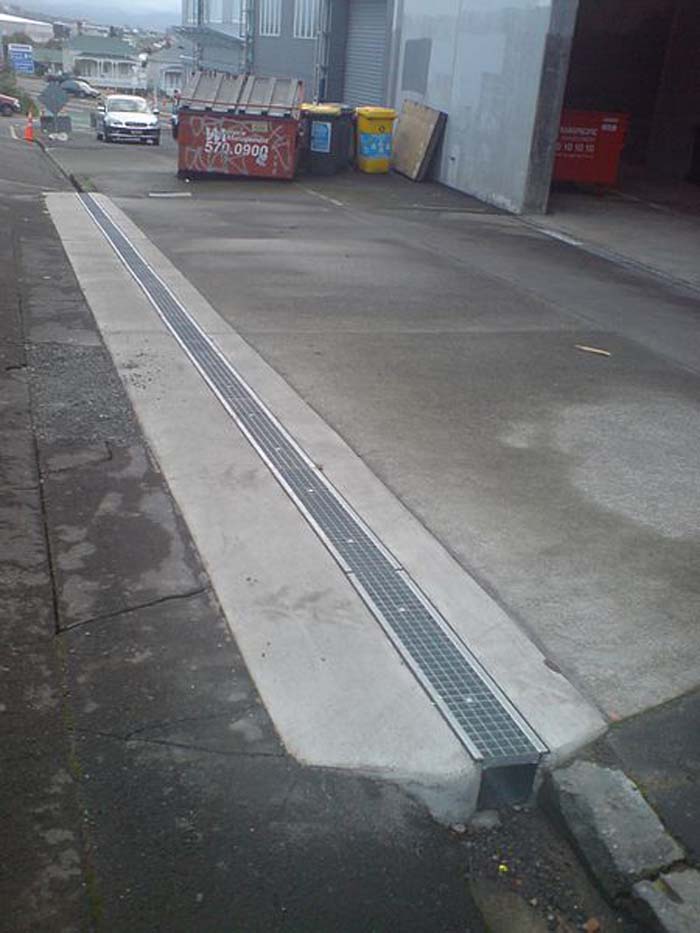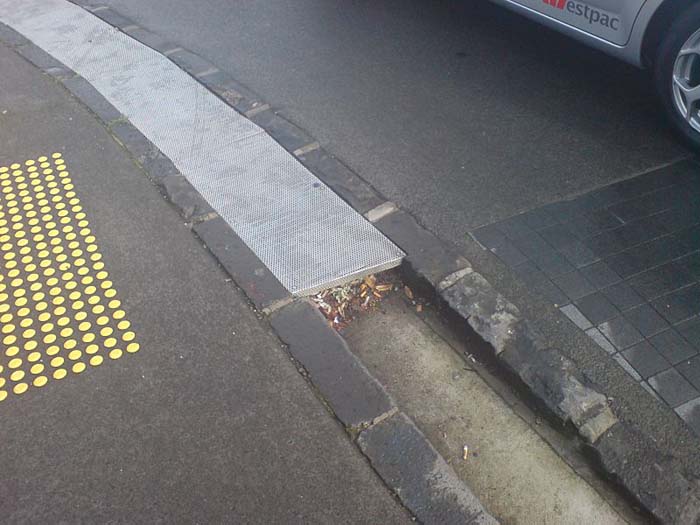
A specialized drainage system known as a driveway channel drain, also known as a linear drain or trench drain, manages surface water runoff and prevents pooling and flooding in adjacent areas and driveways. A standard design involves digging a long, narrow channel into the driveway and covering it with a grate or other material that lets water drain but keeps big objects and debris out.
How to Choose the Right Driveway Channel Drain
There are a number of important factors to consider when choosing a driveway channel drain that will last and effectively handle water. To help you make a well-informed decision, we have provided the following guide:
Assess drainage and water flow requirements.
- Drainage Points
Find out where the water is coming from and where it needs to go, so you can install a driveway channel drain to channel the water efficiently to the right place.
- Water Volume
Think about things like the slope of your driveway, the amount of precipitation, and the topography in your area. This will help you get an idea of how much water your driveway needs to manage.
Choose the right materials.
- Metal/Steel
Extremely long-lasting; commonplace in high-traffic or industrial settings. They are capable of withstanding severe stress and huge loads.
- Concrete
Strong and long-lasting, these driveways are perfect for commercial or high-traffic areas. Installation by an expert may be necessary.
- Polymer or plastic
It is durable, simple to set up, and not heavy, making it the perfect driveway surface for low-traffic residential areas.
Selecting the Appropriate Load Rating
- C250 or Above (Heavy Duty)
This product is ideal for driveways, industrial areas, or commercial driveways used by large trucks.
- B125 (Medium Duty)
Driveways with modest traffic, such as vehicles and light trucks, are the perfect fit.
- A15 (Light Duty)
It makes a good choice for residential driveways and locations with occasional foot traffic.
Consider installation and maintenance.
- Maintenance Requirements
Channel drains with detachable grates or designs that are easy to access for cleaning and maintenance are good choices.
- Easy to install
While some channel drains are simple enough for a do-it-yourselfer to install, others may need to be lighter and more complicated, necessitating the assistance of a professional.
Select the correct grate design.
- Slip Resistance
Especially when it’s wet, make sure the grate has a good grip to keep you from slipping.
- Grate Style
Make sure the design fits nicely with the rest of your driveway and the neighborhood. From plain slits to elaborate designs, the choices are endless.
- Grate Material
Material: cast iron, steel, or plastic. Think about eye-catchiness and longevity.

Ensure the correct design and positioning of the drainage.
- Slope and Alignment
To direct water flow toward the drain, position it at a modest angle.
- Integration with Existing Systems
Check that the channel drain fits in with the rest of the drainage system or has an exit point.
Consider the environment and aesthetics.
- Driveway Design
When choosing a driveway channel drain, consider the style of your driveway.
- Ecological Considerations
Engineers have designed certain drains with water filtration devices to lessen their environmental impact.
The purpose of a channel drain
A channel drain, also called a trench drain, collects and sends surplus moisture or surface water to a specific drainage system or outlet. Its goal is to appropriately manage water runoff and prevent erosion, flooding, and infrastructure and property damage.
Some typical applications and functions of a channel drain are as follows:
- Recreational spaces and sports complexes
Channel drains are the best option for keeping recreational areas, stadiums, and sports fields free of waterlogging and in safe condition.
- Drainage for Landscaping and Gardens
Landscaped areas and gardens commonly utilize them to control runoff and maintain healthy soil and plants.
- Commercial and industrial applications
Commercial and industrial settings commonly use channel drains to handle high volumes of water. Areas with heavy wastewater-producing machines, factories, or car washes commonly feature them.
- Structures and Foundation Protection
Installing channel drains around building foundations diverts water away from them, lowering the risk of basement flooding or structural damage.
- Surface Water Management
To avoid flooding or pooling, channel drains collect and reroute surface water away from walkways, parking lots, driveways, and patios.
- Safety for Pedestrians and Vehicles
Channel drains improve safety by lowering the potential for slips and creating a more solid surface for both walkers and vehicles. They help divert water away from walkways and driveways.
The best channel drains
A number of criteria, including the installation setting, drainage capacity, application, durability, and load requirements, need consideration while selecting the most appropriate channel drains. When deciding which driveway channel drain is ideal for your needs, keep in mind the following brands and characteristics:
Applications:
- Commercial/Industrial
Strong, large-capacity drains are necessary for industrial plants, garages, and parking lots.
- Residential
You might not require heavy-duty channel drains for your garden, patio, or driveway. Additionally, you must consider how things look.
Popular Brands:
- MEADRAIN
It is popular for its versatile and easy-to-install modular designs, perfect for a wide range of applications.
- NDS
The company offers reasonably priced plastic channel drains that are great for homes and light businesses.
- Josam
It is popular in demanding environments where long-lasting metal channel drains are required.
- Zurn
Various high-quality plastic and steel channel drains are available to meet varying load requirements.
- ACO
It is popular for its extensive line of channel drains designed for commercial, domestic, and industrial use. ACO offers a variety of materials and weight grades.
Materials:
- Concrete
It is perfect for heavy-duty uses, but cumbersome to set up.
- Stainless or galvanized steel
The product is strong and appropriate for use at medium to high-stress levels.
- Polypropylene/ Plastic
It is easy to carry and use for tasks that require little effort.
Key Features:
- Durability and Corrosion Resistance
When considering the environment, choose materials that can withstand chemicals and weather.
- Grate Options
Grates are available in various designs and materials. Choose based on factors such as safety, durability, and aesthetic appeal.
- Drainage Capacity
Verify that the anticipated water flow is within the channel drain’s capacity.
- Easy to Install
Depending on the model, some channel drains have height adjustments or snap-together designs that make installation a breeze.
- Load Rating
Make sure the drain is strong enough to support the pressure you anticipate. Class ratings (such as C250, B125, A15, etc.) usually reflect this.
Use Cases:
- Driveways and Garages
Prioritize things like load capacity and longevity.
- Patios and Gardens
Lighter loads, as well as aesthetic considerations.
- Commercial and Industrial Areas
Corrosion resistance, heavy-duty materials, and high load capacity.
Your specific requirements and circumstances will determine which driveway channel drain is ideal. Before buying, consider your installation needs, durability, and load capacity.
How long should a good channel drain last?
A properly constructed and set driveway channel drain has the potential to endure for decades, usually twenty to thirty years or even longer. Its durability, though, is conditional on a number of things:
- Ecological Conditions
Factors include the surrounding environment and climate. Exposure to corrosive substances, freezing and thawing cycles, and high temperatures could reduce the drain’s useful life.
- Maintenance and Cleaning
Routine maintenance is crucial to avoid erosion, clogs, and damage. A neglected driveway channel drain will eventually fail, but a well-maintained one will endure far longer.
- Quality of Installation
Installation must be done correctly. Damage is more likely to occur in badly installed drains, which shortens their lifespan.
- Use and Load
How often and how hard you use the drain can affect its lifespan. Drains in industrial environments or high-traffic areas could be prone to premature failure.
- Quality of Materials
The materials selected significantly impact the drain system’s lifespan. Reinforced concrete, cast iron, or stainless steel are high-quality materials that can substantially increase the drain’s lifespan.
Pay attention to these details to ensure a driveway channel drain lasts and works reliably, whether installing one or assessing an old one. Regular inspections and early problem-solving can extend the lifespan of a channel drain system.
How do you size a channel drain?
The expected water flow, the drainage system’s capacity, the installation site’s conditions, and the expected water flow are all important considerations for determining the proper size of a channel drain. Here is a guideline for channel drain sizing:
- Compliance and safety
- Safety
Think about slip resistance and how easy it is to maintain from a safety standpoint.
- Building codes and regulations
Make sure you’re in full compliance by checking the local building codes.
- Estimate the drainage area.
- Surface Area
Determine the total area of water that will be drained into the channel.
- Grade and Slope
The gradient influences drain capacity requirements because a steeper slope accelerates water flow.
- Consider Grate Choices
- Open Area
Grates with a larger opening can accommodate more water flow, but they are not the best choice for every kind of traffic.
- Grate Design
The grate must be strong enough to support the anticipated traffic load and allow enough water to flow through it.
- Calculate the water flow.
- Runoff Coefficient:
This element is significantly influenced by the type of surface. Concrete’s runoff coefficient is high, whereas grasses’ is low. You can estimate the effective drainage area by multiplying the total surface area by the runoff coefficient.
- Intensity of Rainfall
Find out how much rain falls in your area on a regular basis. Local weather agencies generally have this data.
- Account for Drainage Infrastructure
- Connection Points
Before installing the channel drain, ensure it will fit in with the current drainage system.
- Outflow Capacity
Verify that the catch drains or storm sewers downstream of the driveway channel drain can handle the flow.
- Assess the application.
- Traffic Load
Think about the different kinds of pressures that the driveway channel drain will have to handle. The weight a parking lot drain must support is far greater than that of a backyard garden.
- Residential or Commercial
Find out if the driveway channel drain will be installed in a residential area, such as a pool deck, patio, or driveway, or in an industrial or commercial area, like a loading dock or parking lot.
- Determine the drain capacity.
- Channel Size
Knowing the expected flow rate, you can select a channel drain accordingly. Higher flow rates necessitate deeper or larger channels.
- Flow Rate
Calculate the flow rate by plugging in the effective drainage area and rainfall intensity. To estimate peak flow, use formulas like the rational method.
While sizing a driveway channel drain, consider infrastructure integration, load capacity, and water flow. After collecting relevant data and analyzing the surrounding environment, determine your demands for the drain’s features, capacity, and size.
Conclusion
When selecting the best driveway channel drain, consider the driveway’s material, load rating, water flow, installation, and maintenance needs. Make sure it complies with all applicable local standards, considers environmental factors, and meets your aesthetic, functionality, and durability demands. Consult a drainage specialist or contractor for expert assistance and installation if necessary.
